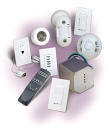April 2007
![]()
AutomatedBuildings.com
[an error occurred while processing this directive]
(Click Message to Learn More)
April 2007 |
[an error occurred while processing this directive] |
|
|

Jim Sinopoli PE, RCDD Author of "Smart Buildings" |
Smart buildings have multiple financial impacts on the owners, managers and tenants of a building. They produce operational savings for the BAS, life safety and user systems that encompass a smart building. More importantly, they can provide efficiencies to the business operation processes within a building, the best example being healthcare. Smart Buildings can also generate revenue for an owner by providing telecom services to tenants and through advertising via digital signage.

|
|
|
|
|
|
|
|
|
|
|
|
|
|
|
|
|
|
|
|
|
[an error occurred while processing this directive] |
With new building construction however, the owner’s financial focus is on the upfront capital construction cost of the building. The budget for construction of a building is arrived at during the project conception. At this stage the owner’s needs and requirements are determined and a budget and schedule are established. During this conceptual process an owner’s priorities for the building are reconciled with the construction budget in the trade off process between the owner’s wants, needs and available monies.
More and more owners are becoming aware of the advantages of smart buildings. They are not only considering the approach in this early conceptual process, but using the functionality that the technology can provide to drive the design and “experience” of their building. Despite that trend, the construction budgets for many projects are set before any discussion or consideration of whether or not the building should be “smart”.
Even with a set construction budget and no thought of constructing a smart building, integrating building technology systems can make sense to the design and construction team. This is because almost all of the building technology systems (BAS, life safety and user systems) will be installed in a building regardless of whether the building is designed and constructed in a traditional method or as a smart building. Simply put, smart buildings just remove the redundancy and inefficiencies of the multiple cables, contractors, cable pathways, equipment and network protocols that are inherent in the legacy design and construction process.
Removing the redundancy saves capital construction monies. How so? Here are a couple examples:
• CABLING
 How many times
during the construction of a building is Contractor A running a cable down a
hallway on a Monday and Contractor B is running a cable down the same hallway on
Tuesday? Given the fact that about 50% of the cost of cable installation is
labor, do you think there could possibly be some efficiencies and cost savings
if one contractor installed both cables down the hallway? You can’t completely
eliminate the labor cost of putting in the second cable, primarily because it
still needs to be terminated, but depending on the cable density and type of
building, 25-40% of labor cost is saved. That’s 12-20% of the overall cost of
the cable installation that can be saved when the cable infrastructure is
consolidated and installed by one contractor. Assuming that 30% of the cost of
installing each of the building technology systems is related to cable, that
translates to a 4-6% saving on all systems. Not huge, but a good starting point.
How many times
during the construction of a building is Contractor A running a cable down a
hallway on a Monday and Contractor B is running a cable down the same hallway on
Tuesday? Given the fact that about 50% of the cost of cable installation is
labor, do you think there could possibly be some efficiencies and cost savings
if one contractor installed both cables down the hallway? You can’t completely
eliminate the labor cost of putting in the second cable, primarily because it
still needs to be terminated, but depending on the cable density and type of
building, 25-40% of labor cost is saved. That’s 12-20% of the overall cost of
the cable installation that can be saved when the cable infrastructure is
consolidated and installed by one contractor. Assuming that 30% of the cost of
installing each of the building technology systems is related to cable, that
translates to a 4-6% saving on all systems. Not huge, but a good starting point.
• CABLE PATHWAYS
If you consolidate the cable installation, you also consolidate the cable
pathways. Pathways are the J-hooks, cable tray and conduit needed to install the
cable. Costs for the cable pathways are part of the overall construction budget,
although they may be carried in the portion related to the electrical work.
That’s because the electrical contractor installs conduit and cable tray.
Industry analysis has shown that material cost of pathways is about the same in
an integrated approach, but like the cabling, the consolidation drastically
reduces the installation labor. Additional efficiencies can be realized by
addressing pathways for both low voltage and high voltage distribution in a
coordinated approach. Potential cost savings are dependent on the type of space
and the density of pathways, possibly ranging from 15% to as high as 60%.
However, for the purpose of presenting conservative Capex savings, let’s assume
savings on the order of the cable itself, that is, 4-6% of the overall pathway
costs.
• PROJECT MANAGEMENT
When the technology systems are installed separately, the project has many
more contractors or subcontractors involved. Each contractor mobilizes a
workforce and has to be managed, monitored, and coordinated by the general
contractor. A great deal of overhead is created this way. Approximately 30% of
the project management for the systems is eliminated by consolidating the
systems and cable installation. Assuming project management is 8% on top of the
total cost for the installation of all the systems, savings is on the order of
2-3% of total cost.
• EQUIPMENT
Integration of the systems also involves the consolidation of servers for
the systems. This consolidation results in less hardware, less space and
reductions in software licenses. This may be small savings, but is still savings
resulting from squeezing out the redundancy and inefficiencies of the legacy
approach to system deployment.
[an error occurred while processing this directive]
• TRAINING
Integration of the systems also affects the number and functionality of the
system administration workstations. Each system does not have to have its own
dedicated workstation. Administration can be accomplished through standard
browser and GUI interfaces. This allows a manager to access (as authorized)
multiple systems through a similar interface and to do so locally or remotely.
It results in less training of personnel on system management tools and
platforms, and less equipment. This may be a small savings initially, but has a
much larger impact over the lifecycle of the systems. Quantifying the savings is
project dependent.
• TIME TO COMMISSION
Time is money. Integrated systems not only take less time to install, but
also less time to configure. The use of shared standardized databases compliant
with SQL and ODBC, and tools such as XML and SOAP, allow for easier integration
between the building technology systems, as well as between the building
technology systems and the organization’s business systems, such as purchasing,
human resources, etc. Less time to commission means less cost.
• POWER
Power-Over-Ethernet is the most under-valued technology for the construction
and operation of a building. Even though systems could be integrated without the
use of PoE, the capital and operational savings from the use of POE is so
compelling that it needs to be an integral part of the installation and
operation of smart building systems. As an example, a card reader that is part
of an access control system typically requires both a communication cable and
local power. How much is saved if the communication cable can also provide the
power? By eliminating the need for local power, probably $250 per outlet can be
saved during construction and close to $750 after construction.
The Capex savings related to a smart building approach is very dependent on building type, size, local construction market, etc. The hard dollar savings in the construction is related to cable, cable pathways and project management. This is on the order of 15%. The consideration of the cost savings and value of less equipment, less personnel training, less time to commission and the use of POE, easily drives this to the 20% range.
To most building owners and those involved in the design and construction of a building, the case for smart buildings should be intuitive. It involves reducing redundancies, improving efficiencies and saving construction monies.
For more information about smart buildings or systems design services email me at info@smart-buildings.com.
[an error occurred while processing this directive]
[Click Banner To Learn More]
[Home Page] [The Automator] [About] [Subscribe ] [Contact Us]